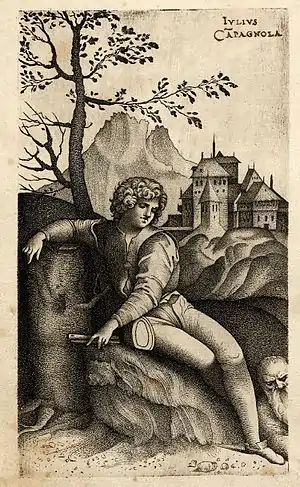Stippling
Stippling is the creation of a pattern simulating varying degrees of solidity or shading by using small dots. Such a pattern may occur in nature and these effects are frequently emulated by artists.
.jpg.webp)
Art

In a drawing or painting, the dots are made of pigment of a single colour, applied with a pen or brush; the denser the dots, the darker the apparent shade—or lighter, if the pigment is lighter than the surface. This is similar to—but distinct from—pointillism, which uses dots of different colours to simulate blended colours.[1]
In printmaking, dots may be carved out of a surface to which ink will be applied, to produce either a greater or lesser density of ink depending on the printing technique. In engraving, the technique was invented by Giulio Campagnola in about 1510. Stippling may also be used in engraving or sculpting an object even when there is no ink or paint involved, either to change the texture of the object, or to produce the appearance of light or dark shading depending on the reflective properties of the surface: for instance, stipple engraving on glass produces areas that appear brighter than the surrounding glass.
The technique became popular as a means of producing shaded line art illustrations for publication, because drawings created this way could be reproduced in simple black ink. The other common method is hatching, which uses lines instead of dots. Stippling has traditionally been favoured over hatching in biological and medical illustration, since it is less likely than hatching to interfere visually with the structures being illustrated (the lines used in hatching can be mistaken for actual contours), and also since it allows the artist to vary the density of shading more subtly to depict curved or irregular surfaces.
Images produced by halftoning or dithering and computer printers operate on similar principles (varying the size and/or spacing of dots on paper), but do so via photographic or digital processes rather than manually. These newer techniques have made it possible to convert continuous-tone images into patterns suitable for printing, but artists may still choose stippling for its simplicity and handmade appearance. The Wall Street Journal still features stippled and hatched portraits known as hedcuts (a style brought to the WSJ by Kevin Sprouls in 1979) in its pages, a holdover from its earlier avoidance of photographs.
Due to the constraints of deferred shading, stippled transparency, where some pixels are fully opaque and some fully transparent, has become common for 3D models in some video games.
Botany

In description of flora species, a stippling is a kind of pattern, especially in the case of flowering plants, produced in nature that occur on flower petals and sepals. These are similar to the dot patterns in artworks that produce an often intricate pattern. An example can be seen on the base of the petal insides of Calochortus luteus, a lily endemic to California.[2]
Other uses
The term stipple can also apply to a random pattern of small depressions applied to a surface to increase the friction and make the surface easier to grip. This process is similar to knurling or checkering, but is often used on complex curved surfaces, such as anatomical grips, where a regular pattern would not fit. Stippling can be cast into plastic objects, or applied with a hammer and punch to wood or metal objects.
A further use of stipple indicates the damage caused by spider mites which make tiny white spots on plant leaves which can coalesce until the entire leaf appears silvery.
In quilt making, the term refers to background quilting in heirloom quilts and all-over stitching in others. It is made freehand or with free-motion machine quilting by densely stitching through all layers in a relatively close repetitive design.
In interior decoration, the tips of the bristles of a stippling brush are dabbed onto a freshly painted wall or surface to create a subtle design in the paint. The paint hit by the points is displaced and leaves only a thin dot of paint through which a lighter layer of colour underneath will show through.
In digital photography, stippling refers to image noise similar to film grain.
In forensic science, stippling refers to a pattern of gunshot residue burned into the skin that results from close proximity to a discharged firearm. [3]
In pathology, basophilic stippling refers to the presence of basophilic granules inside RBCs that can signify a variety of diseases.
In digital imagery, the mathematical process of creating halftones through the addition of noise in quantization errors is called dithering, and depending on the algorithm used is very similar in appearance to manual stippling.
References
- Ian Simpson (1987). The Encyclopedia of Drawing Techniques. London: Headline. pp. 62–64. ISBN 978-0-7472-0051-2.
- C. Michael Hogan. 2009. Gold Nuggets: Calochortus luteus, GlobalTwitcher.com, ed. N. Stromberg Archived 2011-10-04 at the Wayback Machine
- "Glossary of Forensic Terms". Alabama Department of Forensic Sciences. U.S. state government. Retrieved 18 August 2018.
External links
 Media related to Stippling at Wikimedia Commons
Media related to Stippling at Wikimedia Commons